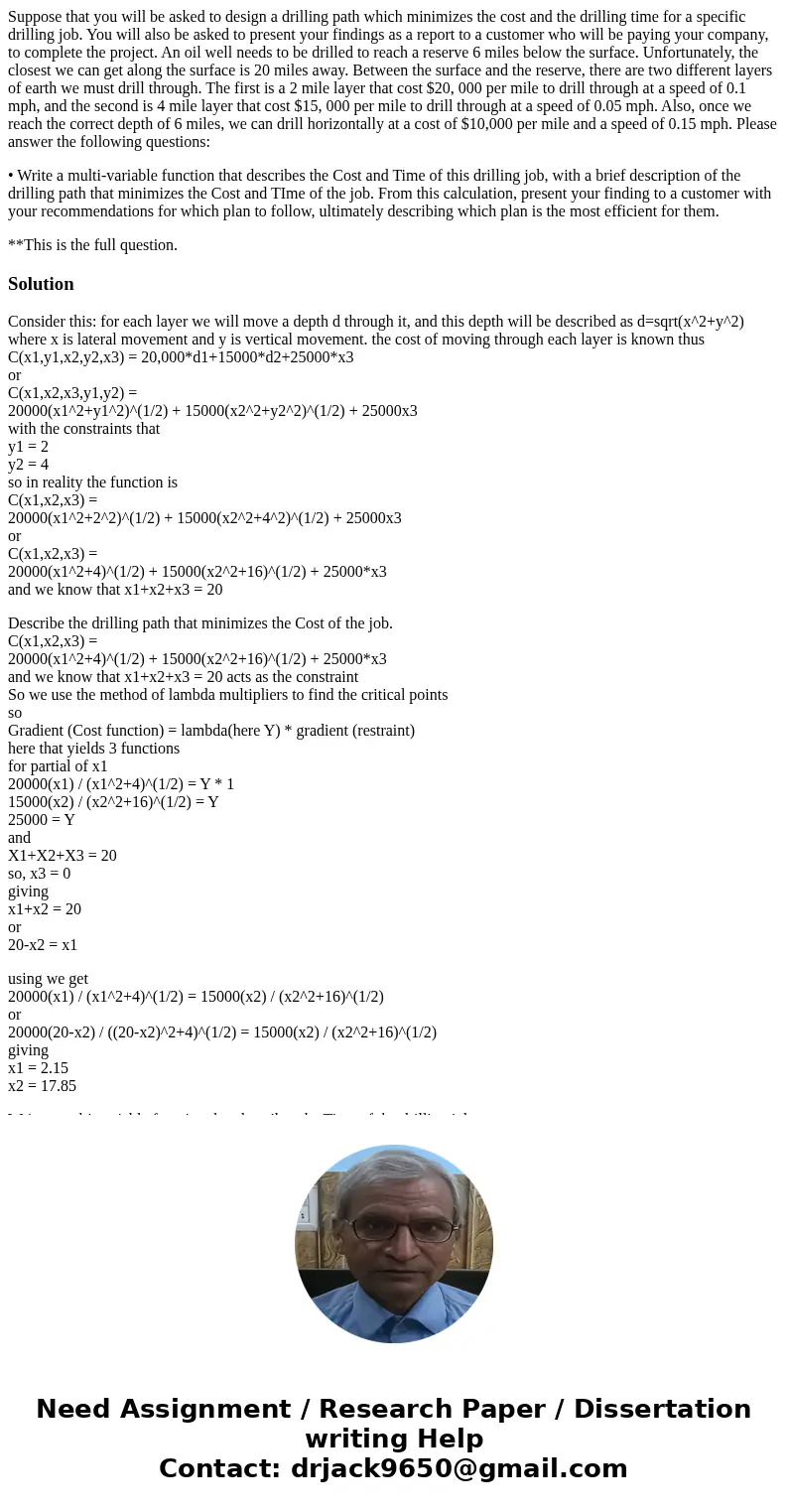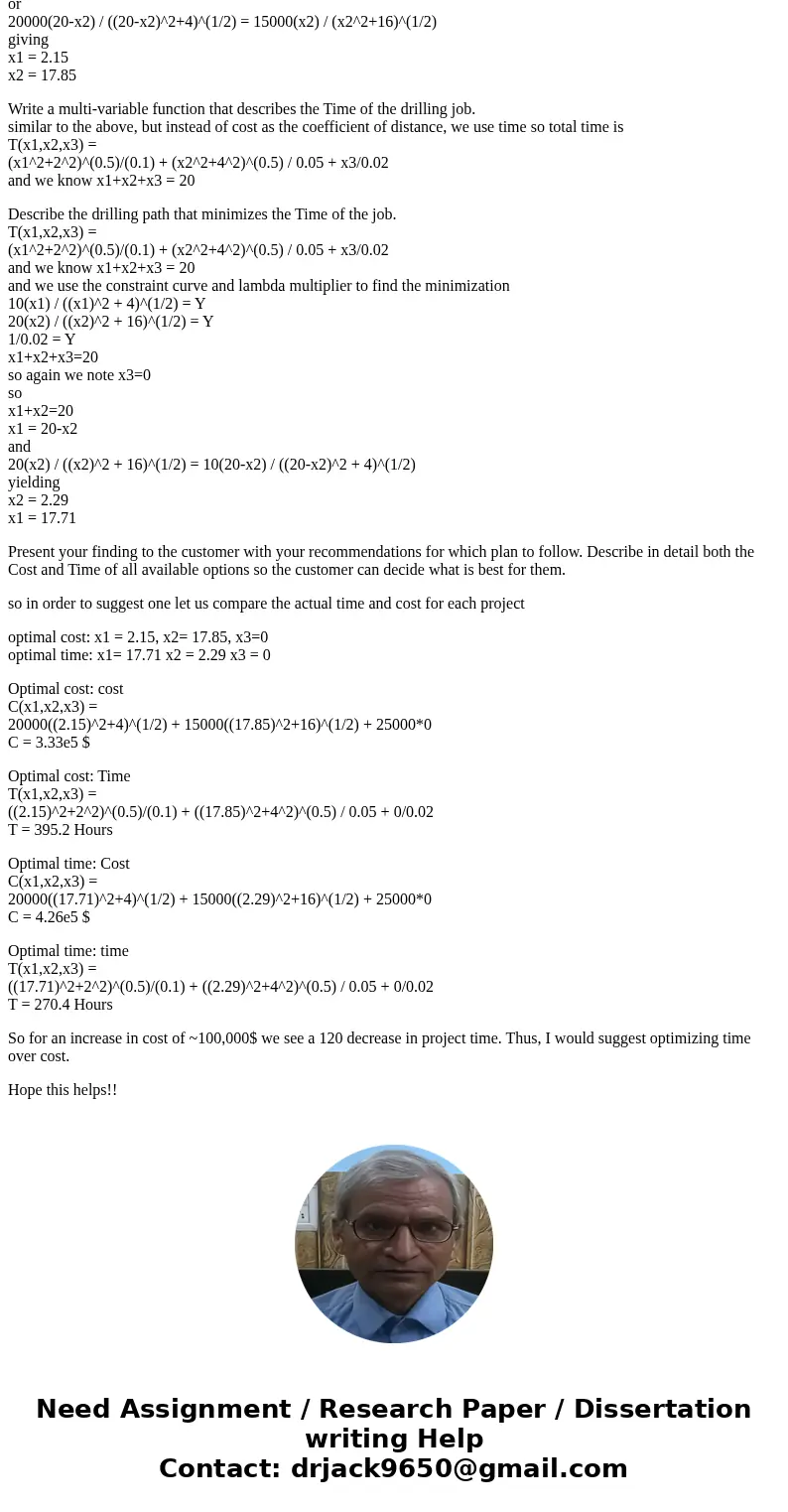Suppose that you will be asked to design a drilling path whi
Suppose that you will be asked to design a drilling path which minimizes the cost and the drilling time for a specific drilling job. You will also be asked to present your findings as a report to a customer who will be paying your company, to complete the project. An oil well needs to be drilled to reach a reserve 6 miles below the surface. Unfortunately, the closest we can get along the surface is 20 miles away. Between the surface and the reserve, there are two different layers of earth we must drill through. The first is a 2 mile layer that cost $20, 000 per mile to drill through at a speed of 0.1 mph, and the second is 4 mile layer that cost $15, 000 per mile to drill through at a speed of 0.05 mph. Also, once we reach the correct depth of 6 miles, we can drill horizontally at a cost of $10,000 per mile and a speed of 0.15 mph. Please answer the following questions:
• Write a multi-variable function that describes the Cost and Time of this drilling job, with a brief description of the drilling path that minimizes the Cost and TIme of the job. From this calculation, present your finding to a customer with your recommendations for which plan to follow, ultimately describing which plan is the most efficient for them.
**This is the full question.
Solution
Consider this: for each layer we will move a depth d through it, and this depth will be described as d=sqrt(x^2+y^2) where x is lateral movement and y is vertical movement. the cost of moving through each layer is known thus
C(x1,y1,x2,y2,x3) = 20,000*d1+15000*d2+25000*x3
or
C(x1,x2,x3,y1,y2) =
20000(x1^2+y1^2)^(1/2) + 15000(x2^2+y2^2)^(1/2) + 25000x3
with the constraints that
y1 = 2
y2 = 4
so in reality the function is
C(x1,x2,x3) =
20000(x1^2+2^2)^(1/2) + 15000(x2^2+4^2)^(1/2) + 25000x3
or
C(x1,x2,x3) =
20000(x1^2+4)^(1/2) + 15000(x2^2+16)^(1/2) + 25000*x3
and we know that x1+x2+x3 = 20
Describe the drilling path that minimizes the Cost of the job.
C(x1,x2,x3) =
20000(x1^2+4)^(1/2) + 15000(x2^2+16)^(1/2) + 25000*x3
and we know that x1+x2+x3 = 20 acts as the constraint
So we use the method of lambda multipliers to find the critical points
so
Gradient (Cost function) = lambda(here Y) * gradient (restraint)
here that yields 3 functions
for partial of x1
20000(x1) / (x1^2+4)^(1/2) = Y * 1
15000(x2) / (x2^2+16)^(1/2) = Y
25000 = Y
and
X1+X2+X3 = 20
so, x3 = 0
giving
x1+x2 = 20
or
20-x2 = x1
using we get
20000(x1) / (x1^2+4)^(1/2) = 15000(x2) / (x2^2+16)^(1/2)
or
20000(20-x2) / ((20-x2)^2+4)^(1/2) = 15000(x2) / (x2^2+16)^(1/2)
giving
x1 = 2.15
x2 = 17.85
Write a multi-variable function that describes the Time of the drilling job.
similar to the above, but instead of cost as the coefficient of distance, we use time so total time is
T(x1,x2,x3) =
(x1^2+2^2)^(0.5)/(0.1) + (x2^2+4^2)^(0.5) / 0.05 + x3/0.02
and we know x1+x2+x3 = 20
Describe the drilling path that minimizes the Time of the job.
T(x1,x2,x3) =
(x1^2+2^2)^(0.5)/(0.1) + (x2^2+4^2)^(0.5) / 0.05 + x3/0.02
and we know x1+x2+x3 = 20
and we use the constraint curve and lambda multiplier to find the minimization
10(x1) / ((x1)^2 + 4)^(1/2) = Y
20(x2) / ((x2)^2 + 16)^(1/2) = Y
1/0.02 = Y
x1+x2+x3=20
so again we note x3=0
so
x1+x2=20
x1 = 20-x2
and
20(x2) / ((x2)^2 + 16)^(1/2) = 10(20-x2) / ((20-x2)^2 + 4)^(1/2)
yielding
x2 = 2.29
x1 = 17.71
Present your finding to the customer with your recommendations for which plan to follow. Describe in detail both the Cost and Time of all available options so the customer can decide what is best for them.
so in order to suggest one let us compare the actual time and cost for each project
optimal cost: x1 = 2.15, x2= 17.85, x3=0
optimal time: x1= 17.71 x2 = 2.29 x3 = 0
Optimal cost: cost
C(x1,x2,x3) =
20000((2.15)^2+4)^(1/2) + 15000((17.85)^2+16)^(1/2) + 25000*0
C = 3.33e5 $
Optimal cost: Time
T(x1,x2,x3) =
((2.15)^2+2^2)^(0.5)/(0.1) + ((17.85)^2+4^2)^(0.5) / 0.05 + 0/0.02
T = 395.2 Hours
Optimal time: Cost
C(x1,x2,x3) =
20000((17.71)^2+4)^(1/2) + 15000((2.29)^2+16)^(1/2) + 25000*0
C = 4.26e5 $
Optimal time: time
T(x1,x2,x3) =
((17.71)^2+2^2)^(0.5)/(0.1) + ((2.29)^2+4^2)^(0.5) / 0.05 + 0/0.02
T = 270.4 Hours
So for an increase in cost of ~100,000$ we see a 120 decrease in project time. Thus, I would suggest optimizing time over cost.
Hope this helps!!


 Homework Sourse
Homework Sourse